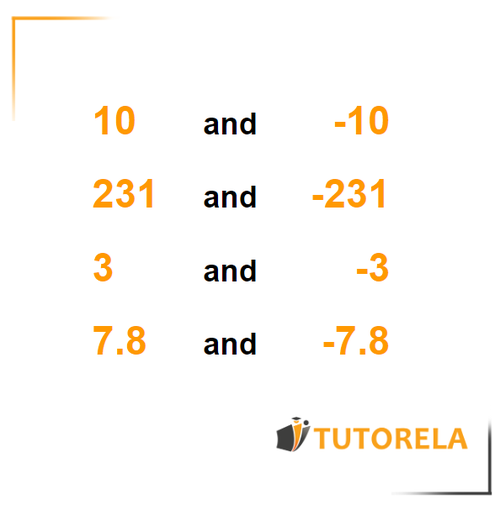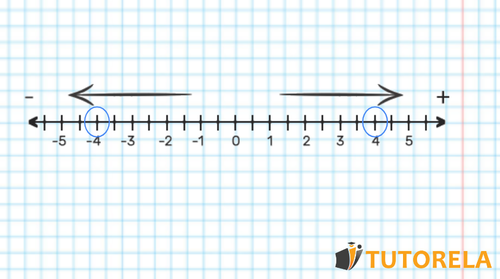In the previous articles we studied about the number line and integers. In this article we will explain what opposite numbers are, and how to identify them.
Opposite numbers
What are opposite numbers, and how to identify them?
Opposite numbers are numbers that when added together result in the number .
The opposite of a number has the same absolute value, but with opposite sign.
Examples:
- and are opposite numbers.
- and are opposite numbers.
- and are opposite numbers (fractions).

Test yourself on basic definitions!
What is the inverse number of \( 0.7 \)
As we have already studied in previous articles, in positive numbers, the plus sign can be omitted.
So it is that:
- and are opposite numbers.
- and are opposite numbers.
As we have already said, when we add two opposite numbers, the result is .
Examples:
Also when we add the result is zero. Therefore, the number opposite zero is zero itself. This is a special case.
Do the following exercises, applying what we have studied in this article:
- Of the following numbers, which pairs are opposite numbers?
2. Create addition operations, in which the result of each one of these will give us .
3. Fill in the blanks, to get the number opposite the number shown.
- __
- __
- __
- __
- __
4. What is the opposite of the following numbers?
5. Based on what you have learned about the topic absolute value Determine if the following pairs of numbers are opposites:
What is the additive inverse number of \( 87 \)
What is the inverse number of \( 5 \)
What is the inverse number of \( -7 \)
If you are interested in this article you may also be interested in the following articles
Positive and negative numbers and zero
Elimination of parentheses in real numbers
Addition and subtraction of real numbers
Multiplication and division of real numbers
On the Tutorela blog you will find a variety of articles about mathematics.
Review questions
What are the opposite or symmetrical numbers?
The opposite numbers or also called symmetric numbers are those that have the same number, but with opposite sign, we can also define them as those numbers that are at the same distance from zero on the number line. For example, in the following line we have and these two numbers are symmetrical, since they have different signs and are at the same distance from zero.

\( (+43)-(+15)= \)
\( (+71)+(-18)= \)
What is the inverse number of \( -0.25 \)
What do the opposite numbers mean?
They mean that they are at the same distance from zero, opposite numbers mean that they have the same quantity but with different signs, for example: and or and .
How to make the opposite numbers?
In order to find the opposite or symmetric numbers we just write the same number but with the opposite sign, for example we are going to write the opposites of the following numbers:
- we write again the same number but in this case as it is negative then its symmetric will be positive.
- its symmetric number will be the same number but with opposite sign, that is,
- we write the same number but with opposite sign .
Ejemplos y ejercicios con soluciones de números opuestos
Exercise #1
What is the inverse number of
Video Solution
Step-by-Step Solution
To determine the opposite number of , we will simply change its sign, following these steps:
- Step 1: Identify the given number, which is .
- Step 2: Change the sign of to find its opposite. Since is positive, its opposite will be negative.
By changing the sign of , we get . Therefore, the opposite number of is .
In conclusion, the solution to the problem is .
Answer
Exercise #2
What is the inverse number of
Video Solution
Step-by-Step Solution
To solve the problem of finding the opposite number of , we will use the concept of opposite numbers:
- Step 1: Identify the given number, which is .
- Step 2: Determine the opposite number by changing the sign. The opposite of is calculated as follows:
The opposite of a negative number is its positive counterpart. So, the opposite of is .
Therefore, the answer is .
Answer
Exercise #3
What is the additive inverse number of
Video Solution
Step-by-Step Solution
To solve this problem, we'll follow these steps:
- Step 1: Identify the given number
- Step 2: Apply the definition of an opposite number
- Step 3: Conclude with the opposite number
Now, let's work through each step with detailed explanations:
Step 1: We are given the number . This is a positive integer.
Step 2: The definition of an opposite number states that the opposite of any number is . Here, .
Step 3: Using the definition, the opposite number of is calculated as .
Therefore, the solution to the problem is .
Answer
Exercise #4
What is the inverse number of
Video Solution
Step-by-Step Solution
To solve this problem, we'll follow these steps:
- Step 1: Identify the given number.
- Step 2: Find its opposite by changing the sign.
Now, let's work through each step:
Step 1: The problem gives us the number .
Step 2: The opposite of a positive number is the same number with a negative sign.
Thus, the opposite of is .
Therefore, the opposite number of is .
Answer
Exercise #5
What is the inverse number of
Video Solution
Step-by-Step Solution
To determine the opposite number of , we need to understand what the opposite of a number means in mathematics.
The opposite of a number is simply a number with the same magnitude but the opposite sign. For any real number , its opposite is . When is already negative, its opposite is positive.
Given the number , we will apply the following steps:
- Identify the sign and magnitude: The given number is , a negative fraction.
- Apply sign change: The opposite is simply the positive version of , which is .
Thus, the opposite of is .
Therefore, the correct answer is .
Answer
What is the inverse number of \( -\frac{8}{7} \)
\( (+0.5)+(+\frac{1}{2})= \)
\( (-2^2)-(-3\frac{3}{4})= \)
- The Order of Basic Operations: Addition, Subtraction, and Multiplication
- Addition and Subtraction of Real Numbers
- Multiplication and Division of Real Numbers
- Integer powering
- Positive and negative numbers and zero
- Real line or Numerical line
- The commutative property
- The Commutative Property of Addition
- The Commutative Property of Multiplication
- The Associative Property
- The Associative Property of Addition
- The Associative Property of Multiplication
- The Distributive Property
- The Distributive Property for Seventh Graders
- The Distributive Property of Division
- The Distributive Property in the Case of Multiplication
- The commutative properties of addition and multiplication, and the distributive property
- Exponents and Roots - Basic
- What is a square root?
- Square Root of a Negative Number
- Exponents and Exponent rules
- Basis of a power
- The exponent of a power
- Powers









